How to Catch Yellowfin Tuna: Complete Guide to Techniques, Gear, and Locations
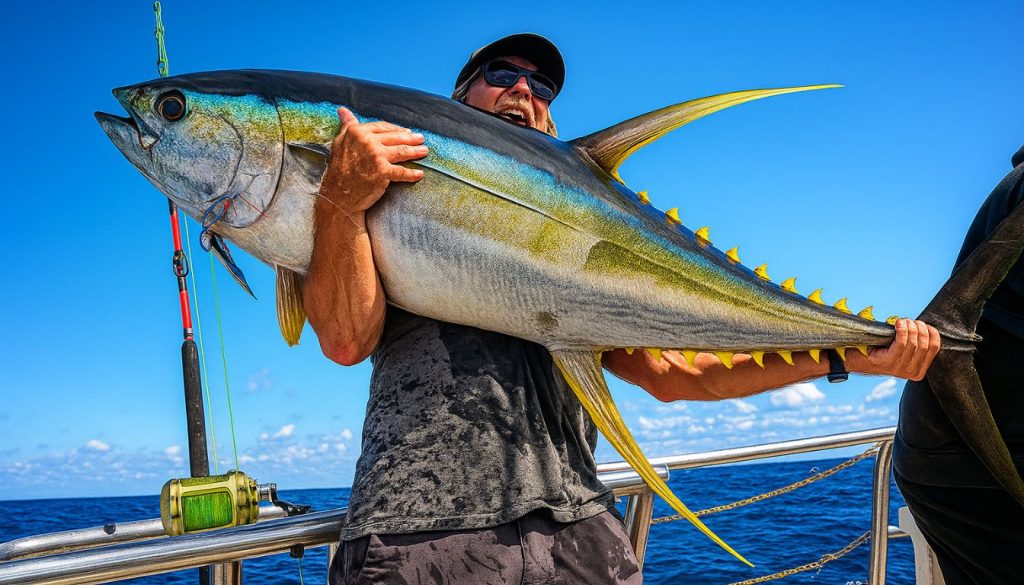
Species Profile
Quick Identification
Yellowfin tuna (Thunnus albacares) is a large torpedo-shaped pelagic fish renowned for its bright yellow fins and streamlined body. Its back and upper sides are metallic dark blue, fading to silvery white on the belly. The species is commonly called yellowfin tuna in the USA (known as “ahi” in Pacific regions).
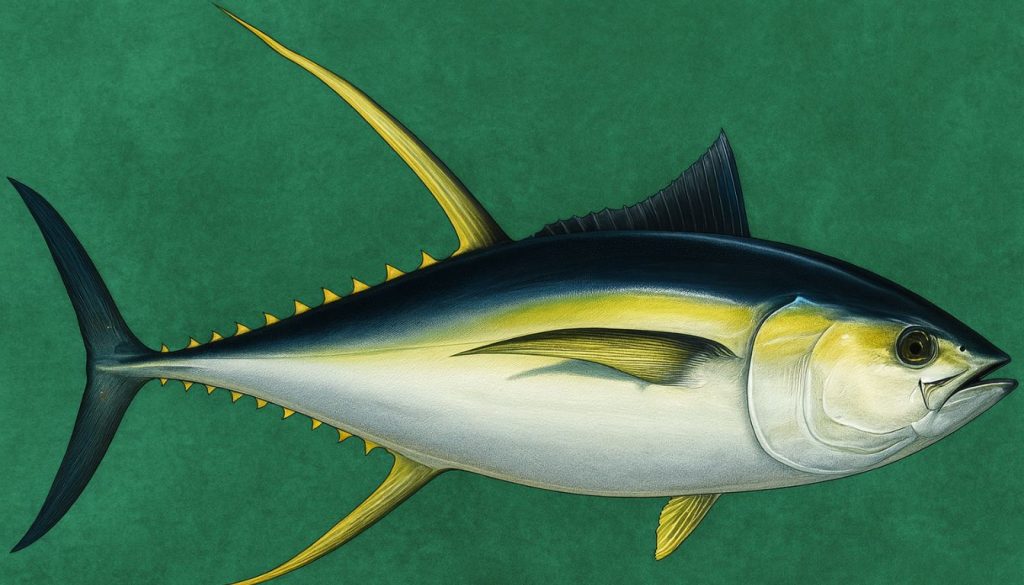
Mature fish develop very long, sickle-shaped second dorsal and anal fins (bright yellow in color), which help distinguish them from other tuna (e.g. they are more slender than bluefin). Yellowfin grow rapidly and can reach up to about 6 ft (1.8 m) long and ~400 lb (180 kg), though exceptionally large specimens exceed this.
For example, the IGFA all-tackle world record is about 443 lb (201 kg) for a yellowfin caught off Mexico in 2024.
Why Target This Species
Yellowfin tuna are prized by sport anglers for their speed, stamina, and thrilling fight. They are among the most exciting offshore gamefish – ranking from Intermediate to Advanced difficulty – because even medium-sized fish (50–100 lb) make long, powerful runs.
A seasoned angler or crew with heavy gear and proper technique can land them, but beginners should start with smaller fish. In addition to the sporting challenge, yellowfins have high culinary value. They are popular in sashimi-grade raw fish dishes and command premium prices as “ahi” tuna in markets. The flesh is firm and mild, excellent seared or raw.
In U.S. waters, yellowfin are most active in warm months: for example, southern California fishermen have their best success roughly July–October, while Florida anglers often find abundant tuna April–September. (In general, late spring through early fall offers peak yellowfin fishing as the ocean warms.)
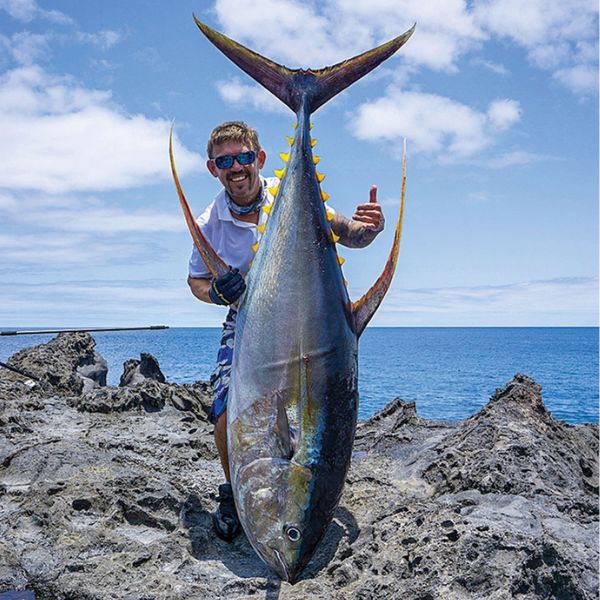
Behavior and Feeding
Hunting Pattern
Yellowfin tuna are fast pelagic predators that actively pursue schooling prey. They usually feed near the surface or just below it, often chasing baitfish in open water. Anglers report that yellowfins tend to move deeper during bright daylight and come up near the surface around dawn and dusk when feeding.
Schools of tuna often feed around sunrise or sunset when light is low. These tuna typically travel in schools of similarly sized fish, mixing with skipjack or juvenile bigeye tuna, especially when young. However, large adults can also roam alone or in small groups.
It is common to find yellowfin associated with floating objects or congregating under flocks of diving birds; these surface signs often indicate feeding tuna below.
Primary Diet
Yellowfin tuna feed on other fish and invertebrates, placing them near the top of the food chain. Their diet consists mainly of fast-moving epipelagic prey – small schooling fish (like anchovies, sardines, mackerel, flyingfish, sauries, frigate mackerel, etc.), along with squid and pelagic crustaceans. Large yellowfins will even take smaller tuna (e.g. skipjack).
Yellowfin Tuna Diet
Apex predator feeding habits that drive successful fishing tactics
🎯 Primary Food Sources
📅 Seasonal & Regional Variations
These seasonal preferences directly influence the most effective bait and lure selection strategies for targeting trophy yellowfin.
Live & Cut Baits
Artificial Lures
Pro Tip: Match the Hatch
The key to consistent yellowfin success is matching the local baitfish in your fishing area. Use weighted, flashy rigs (skirted lures, feathers, or metal jigs) that mimic the size, color, and behavior of the prey yellowfin are actively feeding on. When you see birds diving or bait breaking the surface, that's your signal to deploy lures that imitate what's being hunted!
Seasonal and regional variations occur (e.g. squid in summer nights, small pelagics in warm months). This feeding habit directly shapes bait choice: anglers use natural baits and lures that mimic these prey. For example, live or cut baits like mackerel (bonito), sardines, blue runner or skipjack, and squid strips are top choices to match the tuna’s diet.
Popular live baits include blue runners, bonito or mackerel, and sardines. Because yellowfin often hunt in open water, brightly colored trolling lures and jigs that imitate darting baitfish can also trigger strikes. In practice, matching the hatch (baitfish in the area) and using weighted, flashy rigs (skirted lures, feathers, or metal jigs) will entice feeding yellowfin.
Where and When to Find Them
Key Habitat
Yellowfin tuna are highly migratory and prefer warm offshore waters of tropical and subtropical oceans. In U.S. waters they range from Hawaii and Baja/California in the Pacific to the Gulf of Mexico and the Western Atlantic (Mid-Atlantic to Florida) on the east coast. They are epipelagic fish, mostly staying in the upper water column.
Typically, yellowfin inhabit the top ~100 m (330 ft) of the ocean, though they are capable of diving deeply (over 1,000 m). Preferred habitat features include areas with abundant prey and structure: temperature breaks, current edges, underwater banks or canyons, and floating debris or FADs (fish aggregating devices) tend to concentrate tuna. Offshore oil rigs, seamounts, and weedlines can also attract baitfish and thus tuna.
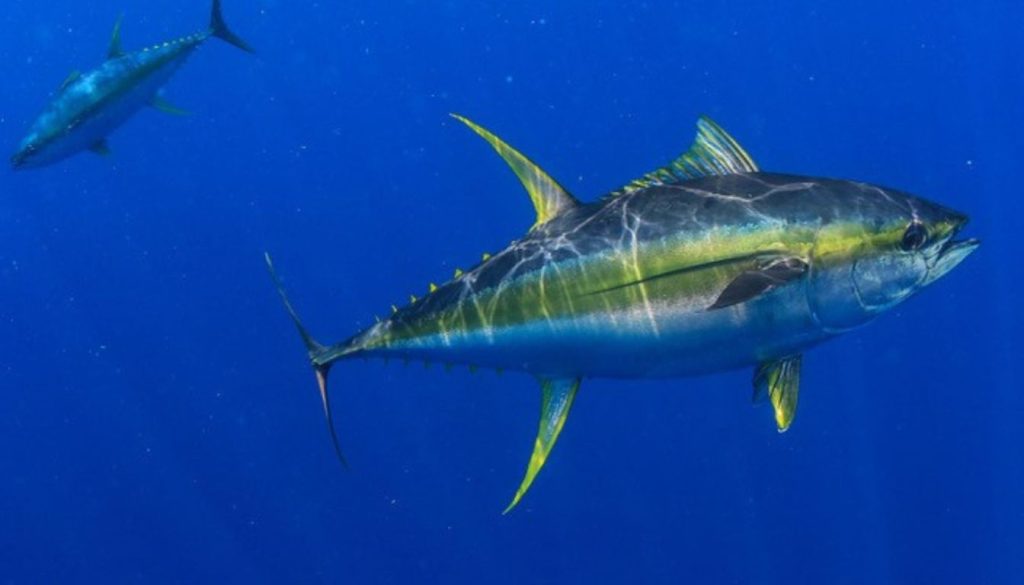
In U.S. fisheries, prime yellowfin hotspots include the Gulf of Mexico (particularly the northern Gulf and around offshore rigs), the Atlantic south-east seaboard (off Florida up to the Carolinas), the Hawaii and Southern California offshore areas, and Baja/Sea of Cortez offshore zones.
For example, NOAA notes juveniles often associate in schools with skipjack in tropical Atlantic waters. In the Pacific, charter boats out of San Diego run 100–300 mi offshore to banks like Hurricane Bank and the Luis Abas (Magdalena) Banks, while Hawaiian fishermen fish the deep edges and FADs near islands.
Fishing Calendar
Yellowfin tuna follow seasonal movements related to water temperature and spawning. In general, peak seasons are late spring through early fall. Along the U.S. Pacific coast (California/Hawaii), the action heats up in summer when waters warm: offshore Southern California sees its main bite from July into October. In the Gulf of Mexico, anglers find fish April through early fall.
On Florida’s east coast, offshore yellowfin can be caught April through September by running past the Gulf Stream edge (the “other side” grounds) and chasing bait schools. Similarly, mid-Atlantic anglers northward from the Carolinas encounter significant yellowfin in summer and into early fall. In contrast, during winter months most U.S. stocks retreat to warmer southern waters or the deep tropical Pacific, though unusually warm periods (El Niño) can bring tuna north earlier.
Knowing seasonal patterns – such as migratory runs toward higher latitudes in summer – helps target trips to the best months.
Water temperature is a key factor: yellowfin prefer 20–30 °C (roughly 68–86 °F). Tracking sea-surface temperature charts is a common strategy: anglers look for thermoclines, currents or fronts that concentrate prey and move into their favored range. For instance, northbound eddies and the cooler edge of the Gulf Stream off Florida concentrate baitfish (and tuna) in spring and summer.
Optimal Conditions
Yellowfin tuna are most active and feed readily under specific conditions. Generally, warm, calm seas make spotting birds and bait easier and encourage tuna to stay near the surface. Golden-hour periods (dawn and dusk) often see heightened activity.
Moderate wind can be beneficial by stirring up nutrient layers and schooling bait, but rough seas can make boat handling difficult. Anglers note that tuna are easily spooked, so a quiet approach (no sudden engine noise or splashing) helps keep them feeding.
Ideal fishing windows are often when baitfish are visibly breaking or birds are diving – these signs, combined with calm light conditions, give the best strike opportunities. In tidal waters, a noticeable current edge or incoming tide can sweep bait into channels; if temperatures are right, tuna will be waiting.
Ultimately, the “perfect” time is when warm water meets abundant prey: such conditions appear sporadically, but paying attention to sea-surface temperature breaks, floating debris (weedlines), and migratory bait (like flying fish slicks) will improve success.
Gear and Techniques
Recommended Setup
Primary Gear: Yellowfin tuna demand stout offshore tackle. A heavy-action rod (roughly 6–7 ft) designed for trolling or jigging is standard. Pair this with a high-capacity reel (conventional or large spinning reel) capable of holding 300–600 yd of braided line. Most outfits use braided line rated 50–100 lb test for backbone, with 60–100 lb fluorocarbon or wire leaders (tuna bite hard and may roll).
For example, anglers often choose rods by St. Croix, Shimano or Penn, with reels like Penn International or Shimano Tiagra. The rationale: heavy braid and big reels give the angler the line capacity and drag to absorb long runs. Drag settings of 20–40 lb are common to control the fight. Also carry fluorocarbon leaders (~60–120 lb) since these are nearly invisible and abrasion-resistant, important if using hard lures or chumming debris.
Alternative Setup: When pursuing truly giant yellowfin or fishing extremely rough water, beef up gear further. “Stand-up” tuna rods rated for 80–130 lb line (with narrow, fishable tips) can be used along with 80–90+ lb class reels. Many anglers employ a fighting belt or harness in this case.
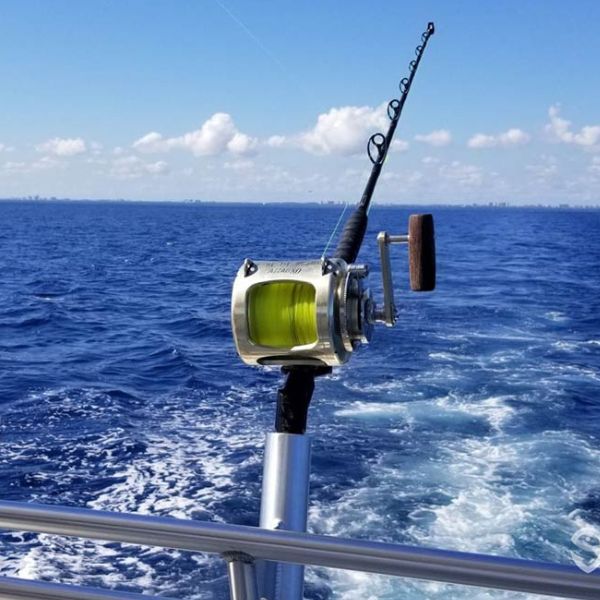
(For instance, one offshore trip report noted using a 200 lb-test fluorocarbon leader and a 40 lb drag setting to land a 192 lb tuna on stand-up gear.) If bundling multiple rods, outriggers and downriggers may be set to spread lines. Regardless of setup, ensure all knots and swivels are heavy-duty (tuna can tie knots with their tails!), and carry spare rigs and hooks.
Effective Baits and Lures
Top 3 Natural Baits:
- Live Mackerel (Bonito/Spanish Mackerel): Rigged on a circle hook through the nose or back, drifting or trolling slowly. Known to entice big yellowfin, especially when fresh.
- Live Sardines or Baitfish (e.g. Pilchards, Blue Runners, Ballyhoo): Hook through the nose on a small livebait hook or circle hook. These run naturally and draw schools.
- Squid Strips or Goggle Eyes: Strung on a wreck-o (cowbell) or handline, especially at night when squid lure lights work. Squid mimic krill or cuttlefish that tuna eat.
(When chunking, anglers often cut small tuna or butterfish into bits and use circle hooks on wire leaders to create a chum slick.)
Essential Lures:
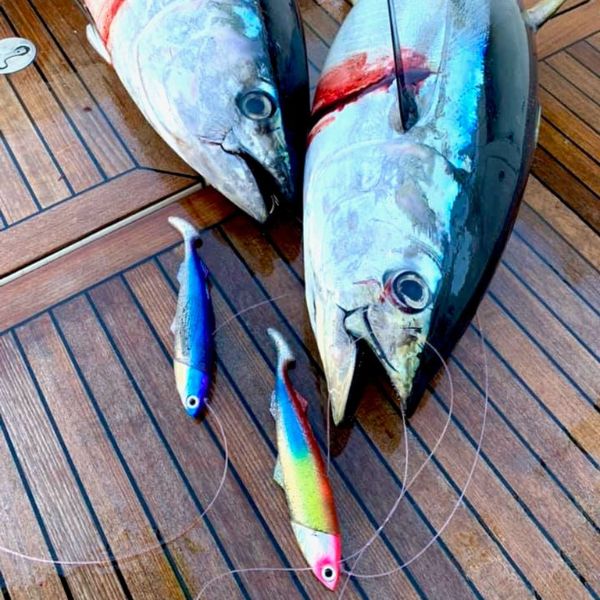
- Skirted Trolling Lures: Large feather jigs or skirted trolling plugs (e.g. “Jet Head” jigs, cedar plugs dressed in feathers or rubber skirts). Colors: bright chartreuse, hot pink, or reflective silver/white often perform well. They imitate baitfish schools when pulled at 5–8 knots.
- Cedar or Plug Lures: Wooden cedar plugs or deep-diving plugs (e.g. Rapala X-Rap Magnum) in natural (silver/blue) or glowing patterns. These dive several meters and can reach tuna feeding just below the surface.
- Metal Jigs: Heavy vertical jigs (100–200 g) dropped to depth and jigged up. Silver or blue slender jigs mimic fleeing bait fish. Effective when yellowfin are deeper or not busting on surface.
- Topwater Poppers/Sticks: When tuna break the surface, throwing a 6–9″ popper or stickbait can draw explosive strikes. Use bright colors and retrieve with sharp pops to simulate distressed prey. This is a “big gun” tactic when you see the boil.
When to use each: Troll skirted lures broadly during the day; switch to live bait or poppers when whales or birds indicate feeding. Jigging is best when a school is under the boat on sonar. As always, vary color and action until you dial in the bite.
Fishing Techniques
Main Technique (Trolling/Live Baiting): Most anglers “cover ground” to find yellowfin. A typical rig is to troll multiple lines: one with a heavy skirted lure or plug, others with bait (live or fresh). Off a slow-moving boat (5–8 knots), spread lines outboard on outriggers or planers.
When birds or bait appear, cut the engine and anchor-drift while deploying live bait under a balloon or down current. Live mackerel or sardines under a float (kite or balloon) is deadly – the balloon detaches at the strike, allowing the angler to fight the tuna unencumbered.
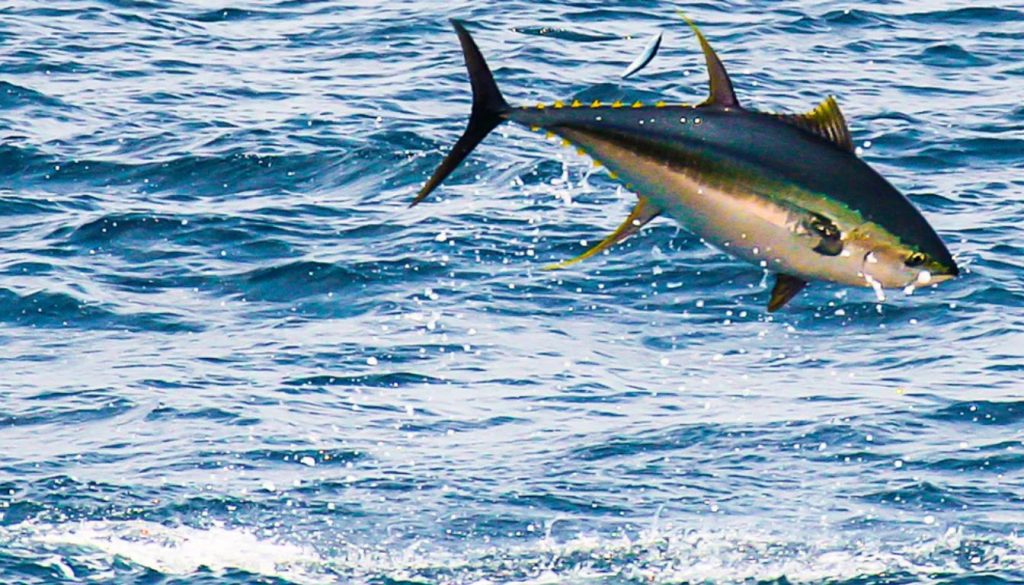
If fish are near the surface, chunking (chumming bits of bait to keep them around) and fishing short “snoods” in the chum line can entice strikes. Key steps: keep lines taught, watch for rod tips to dip, and have a partner free-line any caught baits quickly for a second drop.
Alternative Technique (Jigging/Chumming): If trolling fails, try vertical jigging on a suspended school. Slip a meat (e.g. mackerel fillet) or use a heavy metal jig deep. Then pump the rod vigorously in 2–3 ft lifts and reel steadily down to the depth where tuna are holding (often near 80–200 ft). This jerky action triggers reaction strikes from aggressive fish.
Another option is chunking: throw handfuls of bait chunks to build a chum slick around the boat, then drop baited hooks into the slick and wait. This is effective at night or in calm conditions when tuna come up to feed on scent.
- Pro Tips: Always use circle hooks for live or chunked bait – they tend to hook yellowfin in the corner of the jaw and improve landing and release success. Keep a net or gaff ready and use a gaff long enough to reach a sub-surface tuna when it comes alongside.
Avoid setting multiple lines too close to each other (to minimize tangles) and always trim the prop to prevent tangling with tuna line. Change baits regularly to keep fresh scent, and try matching lure color to local baitfish (if the water is green, try chartreuse; in blue water, try white/blue lures).
Catch and Handling
During the Fight
Fighting a yellowfin requires steadiness and patience. Once a fish strikes, apply steady drag pressure rather than yanking. Use a “pump-and-reel” technique: push the rod down and then reel up during the lift, keeping the line tight to avoid slack.
Be prepared for multiple long runs – tuna will often run, then stop, then run again. As a rule, only give line when the fish is ripping out and try to reel in whenever it slows.
Keep the rod at about 45°–60° to the fish (rod tip up means the fish is tiring). Avoid the common mistake of fighting at too shallow an angle – point the rod high in the gimbal and use your body (back and legs) to resist the pull, not just your arms. Modern rods will bend under heavy strain; when the fish dives, let it run a bit, then crank down and reel continuously once it tires. Near the end, the tuna will circle and come closer; keep the pressure on and walk up on it until you can gaff it safely.
5.2 Catch and Release
If you plan to release a yellowfin, handle it carefully to maximize survival. First, reduce fight time: a brief but firm battle causes less exhaustion. Use circle hooks so that the tuna tends to hook itself in the lip, reducing deep gut-hooking.
When boarding or releasing, support the fish horizontally, not by the jaw alone (which can damage internal organs). Wet your hands or wear gloves to avoid removing the fish’s protective slime. Use pliers to quickly unhook or, if the hook is deep, cut the leader as close to the fish’s mouth as possible (it will be expelled naturally). Keep the gills and eyes free of hands or tools.
Always revive the tuna before full release: hold it facing into a slow-moving current or move it gently back and forth in water to force water through the gills until it can swim away on its own. Barbless circle hooks and quick de-hooking are highly recommended.
As one expert guide notes, safety measures like barbless hooks and compliance with regulations help protect tuna stocks.
For Consumption
For anglers keeping the catch, quick and humane dispatch preserves meat quality. The preferred method is bleeding and ice: as soon as the tuna is gaffed, drive a sharp spike or sharp knife into the brain (behind the eyes) or quickly sever the gills to kill it swiftly.
Immediately insert a knife into the artery at the base of the tail (ventral aorta) and let the blood bleed out into a bucket of seawater – this bright-red bleed-out greatly improves flavor and shelf-life. Then chill on ice (preferably in an ice slurry) as soon as possible; do not let the meat warm up. Yellowfin flesh is best when bled and iced instantly – this is why charter boats keep a livewell full of ice ready.
Quality is maintained by gutting the tuna promptly and keeping the core temperature low. With proper handling (bleed, gut, ice), yellowfin yields excellent sashimi-grade meat. In short, dispatch quickly, bleed thoroughly, and ice immediately to preserve the tuna’s superior taste.
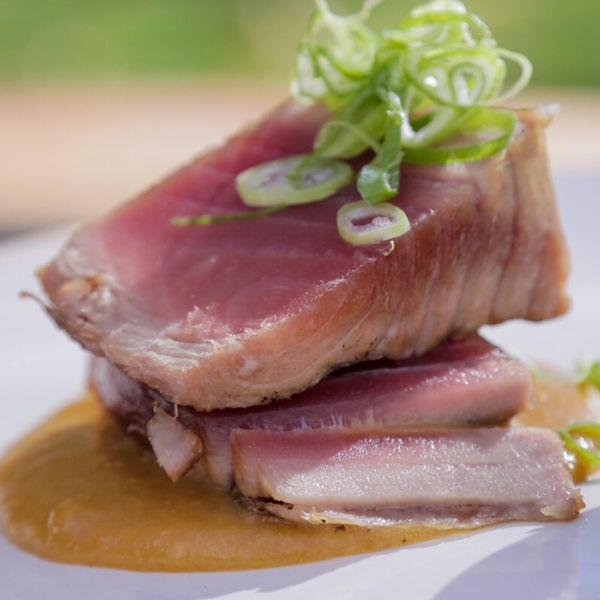
Each of these practices not only ensures the best table fare but also reflects responsible angling for a species so valued by both sport and seafood markets. By using the right techniques, gear and timing for yellowfin tuna, anglers increase their odds of landing this spectacular gamefish while respecting conservation guidelines and maximizing fishery sustainability.
Sources: Authoritative marine and fishing resources were used for this guide, including NOAA Fisheries species profiles
fisheries.noaa.gov, California Sea Grant data
caseagrant.ucsd.edu, and experienced angler guides
bluefin-tackle.com, as cited above.
